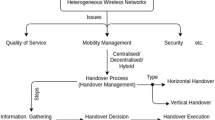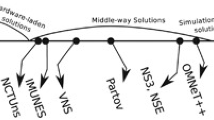Abstract
The complexity of network technologies and the variety of their equipment and settings make them difficult to evaluate, to simulate, and to deploy. IPv4 to IPv6 transition mechanisms are one of the modern issues recently exposed with the emergence of technologies such as Internet of Things, which have practically consumed the existing IPv4 address pools and therefore require a transition to new IPv6 protocol to meet the need. Simulation plays an important role in the modeling, optimization, and evaluation of IPv4–IPv6 transition mechanisms. Through simulation several factors can be studied before the deployment on real environment, such as the transition mechanism, the number of users, the routing protocols, and the transported applications. This paper describes how state-of-the-art network automation can contribute to the development of a new approach for automating the simulation of IPv4 to IPv6 transition techniques based on an interactive graphical platform. The proposed approach can be interfaced with a variety of scientific research simulators guaranteeing the users a reduction in project implementation delay and error rate, the approach can also ensure a simplification of simulator use.










Similar content being viewed by others
References
Lee, D., Choi, K., & Kim, H. (2017). Smart devices & smart spaces in Wireless Internet of Everything (Wireless-IoE). Wireless Personal Communications,94, 145. https://doi.org/10.1007/s11277-017-4103-9.
Matera, F., Listanti, M., & Pióro, M. (2016). Recent trends in network planning to decrease the CAPEX/OPEX cost. Telecommun Syst,61, 205. https://doi.org/10.1007/s11235-015-9994-8.
Camp, T., Kurkowski, S., & Colagrosso, M. (2005). MANET simulation studies: the incredibles. SIGMOBILE Mobile Computing and Communications Review,9(4), 50–61.
Pawlikowski, K., Jeong, H.-D. J., & Lee, J.-S. R. (2002). On credibility of simulation studies of telecommunication networks. IEEE Communications Magazine,40, 132–139.
Perrone, L. F., Cicconetti, C., Stea, G., & Ward, B. C. (2009). On the automation of computer network simulators. In Proceedings of the 2nd International Conference on Simulation Tools and Techniques (p. 49). ICST (Institute for Computer Sciences, Social-Informatics and Telecommunications Engineering).
Virdis, A., Vallati, C., & Nardini, G. (2016). Automating large-scale simulation and data analysis with OMNeT++: Lession learned and future perspectives. In 3rd OMNeT++ Community Summit (pp. 1–4). Brno University of Technology.
Batarseh, O., Huang, E., & McGinnis, L. (2015). Capturing simulation tool and application domain knowledge for automating simulation model creation. Journal of Simulation,9, 1. https://doi.org/10.1057/jos.2014.9.
Lattner, A. D. (2013). Towards automation of simulation studies. Künstliche Intellgenz,27, 287. https://doi.org/10.1007/s13218-013-0259-y.
Riverbed. Riverbed modeler suite. http://www.riverbed.com/products/performance-management-control/network-performance-management/network-simulation.html.
Lu, Z., & Yang, H. (2012). Unlocking the power of OPNET modeler. Chicago: Cambridge University Press.
Rangisetti, A. K., & Tamma, B. R. (2017). Software defined wireless networks: A survey of issues and solutions. Wireless Personal Communications,97, 6019. https://doi.org/10.1007/s11277-017-4825-8.
Bahnasse, A., Louhab, F. E., Oulahyane, H. A., Talea, M., & Bakali, A. (2018). Novel SDN architecture for smart MPLS Traffic Engineering-DiffServ Aware management. Future Generation Computer Systems, 87, 115–126. ISSN 0167-739X. https://doi.org/10.1016/j.future.2018.04.066.
Bahnasse, A., Louhab, F. E., Oulahyane, H. A., Talea, M., Bakali, A. (2018). Smart bandwidth allocation for next generation networks adopting software-defined network approach. Data in Brief, 20, 840–845. ISSN 2352-3409. https://doi.org/10.1016/j.dib.2018.08.091.
Xia, W., Tsou, T., Lopez, D., Lu, F., Sun, Q., Feng, W., et al. (2014). A software defined approach to unified IPv6 transition. In Proceedings of the 2014 ITU Kaleidoscope Academic Conference: Living in a converged world-Impossible without standards? (pp. 9–13). IEEE.
Lin, J. J., Wang, K. C., Cheng, S. M., & Liu, Y. C. (2017). On exploiting SDN to facilitate IPv4/IPv6 coexistence and transition. In 2017 IEEE conference on dependable and secure computing (pp. 473–474). IEEE.
Maojia, S., Congxiao, B., & Xing, L. (2016). A SDN for multi-tenant data center based on IPv6 transition method. In IEEE Information Technology, Networking, Electronic and Automation Control Conference (pp. 190–195). IEEE.
Aggogeri, F., Faglia, R., Mazzola, M., & Merlo, A. (2015). Automating the simulation of SME processes through a discrete event parametric model. International Journal of Engineering Business Management,19(7), 4.
Papadopoulos, A. V., & Leva, A. (2014). Automating efficiency-targeted approximations in modelling and simulation tools: Dynamic decoupling and mixed-mode integration. Simulation,90(10), 1158–1176.
Edwards, R. E. (2013). Automating large-scale simulation calibration to real-world sensor data. Ph.D. diss., University of Tennessee. http://trace.tennessee.edu/utk_graddiss/1715.
Lim, J. B., Jang, B., Yoon, S., Sichitiu, M. L., & Dean, A. G. (2010). Raptex: Rapid prototyping tool for embedded communication systems. ACM Transactions on Sensor Networks (TOSN),7(1), 7.
Bouras, C., Charalambides, S., Drakoulelis, M., Kioumourtzis, G., & Stamos, K. (2013). A tool for automating network simulation and processing tracing data files. Simulation Modelling Practice and Theory, 30, 90–110. ISSN 1569-190X. https://doi.org/10.1016/j.simpat.2012.09.001.
Neugebauer, R., & Schob, U. (2011). Reducing the model generation effort for the virtual commissioning of control programs. Production Engineering,5(5), 539–547.
Drumm, O., Lutz, B., Palmin, A., Wolf, G., inventors; Siemens Aktiengesellschaft, assignee. (2016). Planning and engineering method, software tool and simulation tool for an automation solution. United States patent application US 15/083,525.
Schob, U. (2010). A framework for automating the generation of machine simulation models. In World academy of science: international conference on control and automation.
Legat, C., Steden, F., Feldmann, S., Weyrich, M., & Vogel-Heuser, B. (2014). Co-evolution and reuse of automation control and simulation software: Identification and definition of modification actions and strategies. In IECON 2014-40th Annual Conference of the IEEE Industrial Electronics Society, 29 October 2014 (pp. 2525–2531). IEEE.
Virdis, A., Vallati, C., & Nardini, G. (2016). Automating large-scale simulation and data analysis with OMNeT++: Lession learned and future perspectives. In Proceedings of the 3rd OMNeT++ Community Summit, Brno University of Technology - Czech Republic, 15–16 September 2016, arXiv preprint arXiv:1609.04603.
Mohorko, J., Klampfer, S., Fras, M., & Cucej, Z. (2011). Expert system for automatic analysis of results of network simulation. In Prof. P. Vizureanu (Ed.), 2011 expert systems for human, materials and automation. InTech. https://doi.org/10.5772/18170.
Bahnasse, A., & El Kamoun, N. (2014). Policy-based automation of dynamique and multipoint virtual private network simulation on OPNET modeler. International Journal of Advanced Computer Science and Applications (IJACSA). https://doi.org/10.14569/IJACSA.2014.051201.
Gilligan, R., & Nordmark, E. (2000). Transition mechanisms for IPv6 hosts and routers, RFC 2893. https://doi.org/10.17487/rfc2893.
Carpenter, B., & Moore, K. (2001). Connection of IPv6 domains via IPv4 clouds, RFC 3056. https://doi.org/10.17487/rfc3056.
Conta, A., & Deering, S. (1998). Generic packet tunneling in IPv6 specification, RFC 2473. https://doi.org/10.17487/rfc2473.
Farinacci, D., Li, T., Hanks, S., Meyer, D., & Traina, P. (2000). Generic routing encapsulation (GRE), RFC 2784. https://doi.org/10.17487/rfc2784.
Durand, A., Fasano, P., Guardini, I., & Lento, D. (2001). IPv6 tunnel broker, RFC 3053. https://doi.org/10.17487/rfc3053.
Acknowledgements
The authors would like to express their sincere gratitude for the reviewers and editors for the valuable comments, which is helpful in improving the paper quality.
Author information
Authors and Affiliations
Corresponding author
Additional information
Publisher's Note
Springer Nature remains neutral with regard to jurisdictional claims in published maps and institutional affiliations.
Rights and permissions
About this article
Cite this article
Bahnasse, A., Louhab, F.E., Khiat, A. et al. Novel Approach for Management of Automated IPv6 Network Simulation. Wireless Pers Commun 111, 1487–1504 (2020). https://doi.org/10.1007/s11277-019-06928-4
Published:
Issue Date:
DOI: https://doi.org/10.1007/s11277-019-06928-4




